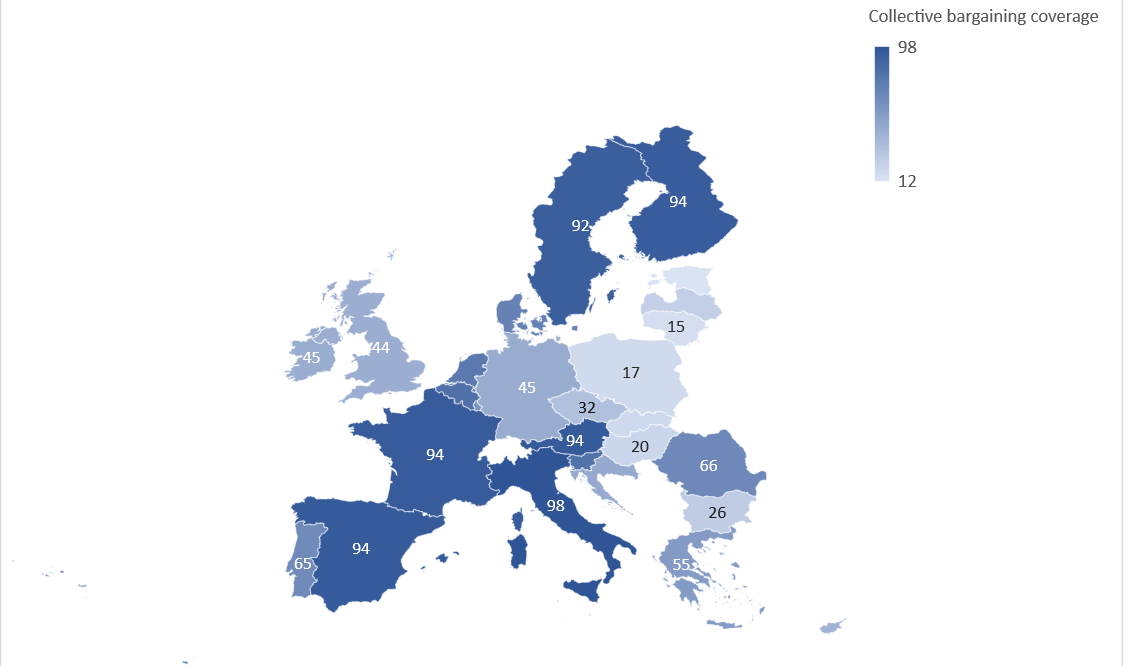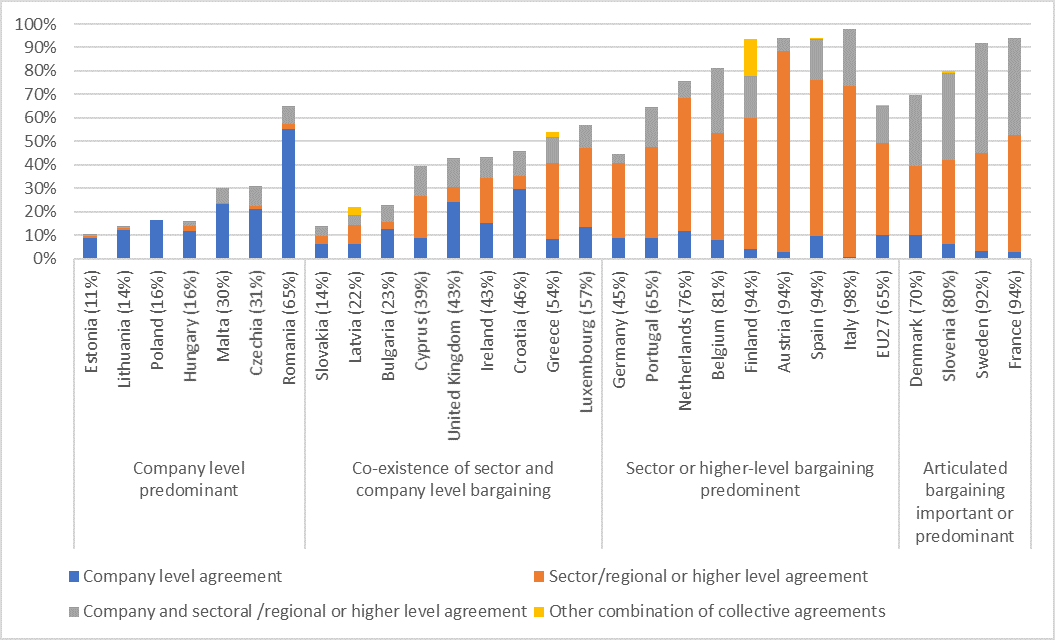New impetus to collective bargaining: Insights from the ECS
In the context of the ongoing trend of a fall in collective bargaining coverage, and recent calls at EU level to promote collective bargaining coverage as an instrument to support fair and decent wages, new data from Eurofound’s fourth European Company Survey (ECS) show that two-thirds of workers (in private sector establishments with more than 10 employees in the EU) are estimated to have their wages set via a collective wage agreement.
New approach to data on collective bargaining in the EU
The European Company Survey (ECS) gathers information – from both management and employee representatives – on workplace level practices in private sector establishments with more than 10 employees. The newest wave – fielded in 2019 – was carried out online and includes a new approach to obtaining information on the type of collective wage agreements adhered to by companies. Presented with a country-specific list of types of agreements (related to different bargaining levels, occupations, regions, etc.), management representatives were asked to select which agreements (if any) determined the wages of ‘at least some of’ their employees. This approach gives a deeper insight into the co-existence of company level with higher level bargaining. The process of ‘articulated’ forms of bargaining is deemed to be quite flexible compared to ‘non-articulated’ forms of bargaining, as it combines a wider coverage of companies and employees, and allows for the possibility to adapt wages to company-specific productivity developments.
Influence of sectoral bargaining
Estimating collective wage bargaining coverage in surveys is tricky, as respondents may not understand the survey question correctly or may lack sufficient knowledge of the issue. While in some cases the estimated numbers in the ECS vary somewhat from other available (national) data, they are based on a harmonised methodology. According to the ECS findings, the lowest levels of wage bargaining coverage is to be found mainly in the Central and Eastern EU Member States (except for Slovenia and Romania). Medium levels of bargaining coverage (around half of the workers covered by wage agreements), are found in Croatia, Cyprus, Germany, Greece, Ireland and the United Kingdom, while medium to high level – 60% to 80% of workers – is recorded in Denmark, Luxembourg, the Netherlands, Portugal and Romania. Countries with the highest collective bargaining coverage (over 80%) – Austria, Belgium, Finland, Italy, France, Spain, Slovenia and Sweden – are those which have strongly developed sectoral bargaining and use legal extension mechanisms or functional equivalents of these more extensively than other Member States. Apart from some smaller ‘surprises’ on the estimated magnitude, which would merit further in-depth investigation [1], the picture obtained via the survey is broadly in line with commonly used statistics. So what is new?
Figure 1: Estimated proportion of employees covered by any form of collective wage agreement in the private sector (%)

Note: Private sector establishments with more than 10 employees.
Source: Estimates by Eurofound (2020), based on fourth European Company Survey 2019, replies from more than 21,000 management respondents.
New insights into patterns of collective wage bargaining
The survey provides a greater insight into bargaining levels and how collective agreements made at different levels might co-exist within the same company.
Four groups of countries were identified on the basis of their pattern of bargaining arrangements:
those with decentralised, predominantly company-based bargaining
those with the coexistence of company- and sector-level bargaining, but no predominance of neither
those with predominantly sector-level bargaining
those where articulated bargaining (between sector and company level) is the predominant form, next to a high degree of sectoral bargaining.
The extent of sector level bargaining continues to be the most important driver for a large bargaining coverage and is particularly important for small- and medium-sized enterprises, as they tend to be much less often covered by company-level agreements.
Figure 2: Patterns of collective wage bargaining coverage (%)

Source: Fourth European Company Survey 2019.
Commentary
Promoting a high collective wage bargaining coverage has recently attracted policy attention at EU level, particularly in the context of the EU minimum wage initiative. The latest ECS data show that countries whose sectoral bargaining coverage is high also have a much larger overall coverage than those where company-level bargaining dominates. Sectoral bargaining came under accelerated pressure during the economic and financial crisis that started in 2008 – affecting some Member States more than others – when there was a push towards more decentralised approaches or no bargaining at all. In contrast, the current pandemic situation could be used as a springboard to promote sectoral bargaining – in particular, the more articulated forms of bargaining. Why is this important? Sectors and even specific activities or companies feel the economic impact differently: while some have profited from the changing economic climate resulting from the COVID-19 pandemic, others are battling to survive. If the aims are to ensure a high coverage of workers with collectively agreed (minimum) wages, to maintain people’s purchasing power to stimulate the economy and to keep the possibility of a company-specific adaptation to economic realities or productivity developments, then a high coverage of workers with sectoral collectively agreed minima – possibly combined or ‘articulated’ with organised decentralised wage setting to improve the sectorally negotiated minima – will be a necessary means towards achieving those goals.
Image © Shutterstock
Footnote
^ Data for Ireland, Greece, Romania and the UK, in particular, appear to be higher than recorded in the ICTWSS 6.1 database (which is not strictly comparable, as it covers the whole economy, including public sector), while the ECS sample is restricted to private sector establishments with more than 10 employees.
Author
Christine Aumayr-Pintar
Senior research managerChristine Aumayr-Pintar is a senior research manager in the Working Life unit at Eurofound. She coordinates Eurofound’s research on social dialogue and industrial relations and oversees the Network of Eurofound Correspondents (NEC). Her primary research expertise – approached from a comparative EU-wide standpoint – centres on minimum wages, collectively negotiated pay and gender pay transparency. Prior to joining Eurofound in 2009 she was a labour markets and regional economics researcher at Joanneum Research in Austria. She earned a Master's degree in Economics and a PhD in Social Science/Economics having studied economics in Graz, Vienna and Jönköping.
Related content
4 June 2020
Minimum wages in 2020: Annual review
This report, as part of an annual series on minimum wages, summarises the key developments during 2019 and early 2020 around the EU initiative on fair wages and puts the national debates on setting the rates for 2020 and beyond in this context. The report features how minimum wages were set and the role of social partners. It discusses developments in statutory minimum wages and presents data on minimum wage rates in collective agreements related to 10 low-paid jobs for countries without statutory minimum wages. The report also includes a section on the regional dimension of minimum wages and presents the latest research into the effects of minimum wage changes on wages, employment, in-work poverty, prices and profits.
11 September 2015
Pay in Europe in different wage-bargaining regimes
National wage-bargaining institutions are crucial in achieving pay outcomes that help to increase employment and economic growth within the context of avoiding macroeconomic imbalances within the European Monetary Union. Using a large set of empirical macroeconomic data from a variety of sources, including Eurofound and the European Commission AMECO database, this report analyses how the institutional features of national wage bargaining regimes influence pay outcomes. These features include bargaining level, type and level of coordination, use of opening clauses and the existence of wage pacts. The impact of government intervention through extension and derogation clauses and tripartite councils is also examined. The results of the study indicate that the key institutional variables of the wage-bargaining regime that influence pay outcomes are the type of coordination (how coordination is achieved) and the bargaining level.